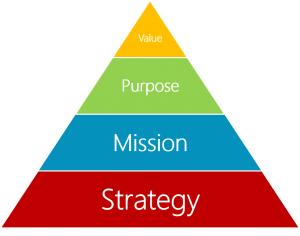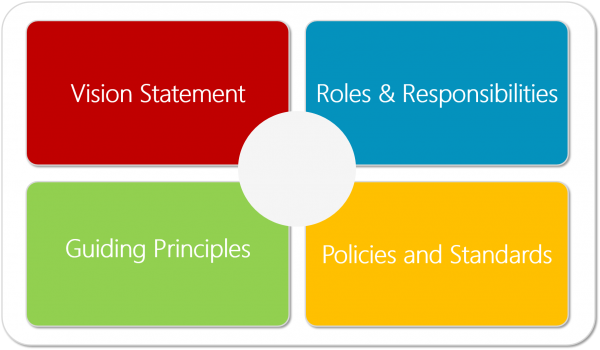Governance is an essential part of any SharePoint deployment. Any organization that has tried to implement SharePoint has undoubtedly asked the question, “How do we effectively manage our SharePoint environment?” Governance is that answer. Governance is a set of policies, procedures, roles, and responsibilities that control how your business teams and IT teams work together to manage, administer, and deploy SharePoint. Every organization has unique needs and requirements for using SharePoint that will influence its approach to governance. 
At Perficient, we strongly recommend every SharePoint deployment be accompanied by a Governance Plan. We have customers who hate even the idea of governance. Its not uncommon as governance is a really tricky subject. Some customers think of it as big brother. Others think of it as a nuisance with no value. And others are resistant because of internal politics or other cultural factors. We understand and at Perficient we do not take a one size fits all approach, rather we will work with each customer individually to craft a governance plan that works for your organization.
Governance is not a bureaucratic process nor is it meant to be a hindrance. A good governance plan can:
- Help an organization streamline deployment
- Protect against security threats
- Ensure that industry best practices are followed
- Provide the best return on such a large investment
Over the years since the release of SharePoint 2007, the industry has recognized the need for governance. I can tell you from experience, in 2007, SharePoint governance was rarely implemented. Most organizations stood up MOSS and let their business go wild, which led to a multitude of problems that a governance plan can help solve.
Why is governance important?
- Avoid content sprawl
- Ensure content quality is maintained for the life of the solution
- Ensure a consistent user experience
- Establish clear decision making authority and escalation procedures
- Ensure the solution is aligned with business objectives
- Ensure content is retained appropriately
How do I get started with governance?
The first step is to identify Key Stakeholders, identify Governance Committee, and identify Content Managers (Site Owners).
What does a typical Governance Committee look like? I can tell you that it is 100% different for every organization. My guidance is somewhere from 7 – 15 members, keep it an odd number for voting reasons, more than 15 and the room can have too many voices, less than 7 and there are too few. Here are some typical roles that may be a part of the committee. Include as many of the following as possible:
| Expenditure Type | Unit Name | Unit Description | (a) Expenditure Category | (b) Revenue Category | (c) Expenditure Type Class |
|---|---|---|---|---|---|
| Administrative | Hours | Administrative | labor | Non-Bill labor | Straight Time |
| Clerical | Hours | Clerical | labor | Non-Bill labor | Straight Time |
| Customer Labor | Hours | Billable Labor Hours | labor | Billable labor | Straight Time |
| Customer Hotel | Dollars | Billable Hotel | Travel | Billable Travel | Expense Reports |
| Customer Supplies | Dollars | Billable Supplies | Supplies | Billable Supplies | Supplier Invoice |
What’s in a governance plan?
A typical governance plan will have 4 main sections:

A vision statement describes, at a high level, what you want to want to achieve with SharePoint Server—essentially how the solution delivers value to the enterprise and to each individual employee. A clear vision statement provides critical guidance to the inevitable decision tradeoffs that you will need to make in thinking about your governance plan. The vision statement is typically written when the project that creates the solution is initiated and may be refined as the project matures.
Roles and responsibilities describe how each employee as an individual or as a member of a particular role or group is responsible for ensuring success of the solution. The Governance Plan defines who has authority to mediate conflicting requirements and make overall branding and policy decisions. In some organizations, many roles may be fulfilled by a single individual.
Guiding principles define organizational preferences that support the vision. These critical statements reflect best practices that all users and site designers must understand and internalize to ensure the success of your solution. It is very likely that your organization will share many of the same guiding principles that we’ve seen in successful SharePoint deployments.
Policies define rules for SharePoint use; standards describe best practices. From a governance perspective, policies are usually driven by statutory, regulatory, or organizational requirements. Users are expected to meet policies without deviation. If your organization is subject to regulatory oversight, be sure you can actually enforce your policies as a failure to do so may target you as being “non-compliant.” Standards are usually established to encourage consistent practices. Users may adopt some elements of the standard that work for them while not implementing others.
What areas should we govern?

Microsoft has done a really great job of publishing information on these 3 areas, for more information visit these links:
IT Governance
Information Management
Application Management
How do I apply governance to different types of sites?
Different types of sites require different governance policies. This is because different sites have different requirements, which reflect their importance to the organization. Published sites have tighter governance over information and application management than team sites and personal sites (My Sites).
Generally, the larger the number of people who get information from a particular type of site, the more tightly it is governed, and vice versa. This is shown in the following graph. For example, if your intranet home page is available for everyone in your organization, it’s generally much more tightly governed than the site for the accounting department, which is more tightly governed than most group or team sites, and so on. Personal sites are generally the least governed types of sites.

What are some best practices for governance plans?
- Determine initial principles and goals. The governance committee should develop a governance vision, policies, and standards that can be measured to track compliance and to quantify the benefit to your organization. For example, your plan should identify service delivery requirements for both technical and business aspects of your SharePoint deployment.
- Classify your business information. Organize your information according to an existing taxonomy, or create a custom taxonomy that includes all the information that supports your business solution. After your information is organized, design an information architecture to manage it. Then, determine the most appropriate IT services to support it.
- Develop an education strategy. The human element is, after the governance plan, the most important ingredient in the success or failure of a SharePoint deployment. A comprehensive training plan should show how to use SharePoint according to the standards and practices that you are implementing and explain why those standards and practices are important. Your plan should cover the kinds of training required for specific user groups and describe appropriate training tools. For example, your IT department might maintain a frequently asked questions (FAQ) page about its SharePoint service offerings, or your business division might provide online training that shows how to set up and use a new document management process.
- Develop an ongoing plan. Successful governance is ongoing. The governance committee should meet regularly to review new requirements in the governance plan, reevaluate and adjust governance principles, and resolve conflicts among business divisions for IT resources. The committee should provide regular reports to its executive sponsors to promote accountability and to help enforce compliance across your organization. Although this process seems complicated, its goals are to increase the return on your investment in SharePoint, take full advantage of the usefulness of your SharePoint solution, and improve the productivity of your organization.
Well, I hope this gives you a nice introduction to SharePoint Governance. If you would like more information or help setting up Governance for your SharePoint deployment, feel free to contact us at Perficient!
